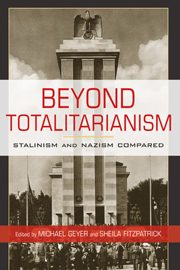Book contents
- Frontmatter
- Contents
- List of Contributors
- Acknowledgments
- Beyond Totalitarianism
- 1 Introduction
- PART I GOVERNANCE
- PART II VIOLENCE
- PART III SOCIALIZATION
- 6 Frameworks for Social Engineering
- 7 Energizing the Everyday
- 8 The New Man in Stalinist Russia and Nazi Germany
- PART IV ENTANGLEMENTS
- Works Cited
- Index
- References
6 - Frameworks for Social Engineering
Stalinist Schema of Identification and the Nazi Volksgemeinschaft
Published online by Cambridge University Press: 05 June 2012
- Frontmatter
- Contents
- List of Contributors
- Acknowledgments
- Beyond Totalitarianism
- 1 Introduction
- PART I GOVERNANCE
- PART II VIOLENCE
- PART III SOCIALIZATION
- 6 Frameworks for Social Engineering
- 7 Energizing the Everyday
- 8 The New Man in Stalinist Russia and Nazi Germany
- PART IV ENTANGLEMENTS
- Works Cited
- Index
- References
Summary
All modern states engage in the practices of identifying and categorizing their populations. This organizational work seems critical to the achievement and maintenance of states' authoritativeness. The power of the state as an “identifier” has been related to its possession of “the material and symbolic resources to impose the categories, classificatory schemes, and modes of social counting and accounting with which bureaucrats, judges, teachers, and doctors must work and to which non-state actors must refer.” So unlike in other respects, the USSR under Stalin and Nazi Germany both experienced radical recategorizations of their respective populations. In this essay we seek to clarify the nature of the relationship between the identifying practices that each state employed and its agenda for massive social engineering.
Both the Stalinist schema of identification and the Nazi ideal of Volksgemeinschaft were animated by the desire to transform society in the image of certain ascribed qualities. In the case of Soviet Russia, these revolved around class, later to be supplemented and even supplanted by nationality. For the Nazis, purification of the racially defined community became the paramount objective of social policy. Identification in this sense was a necessary (but not sufficient) activity in the production of new social identities that lay at the core of both the Stalinist and Nazi agendas for social change. The degree to which each realized its agenda is highly debatable, but there is little doubt that these “illiberal” regimes impinged on and legitimated new identities.
- Type
- Chapter
- Information
- Beyond TotalitarianismStalinism and Nazism Compared, pp. 231 - 265Publisher: Cambridge University PressPrint publication year: 2008
References
- 1
- Cited by

